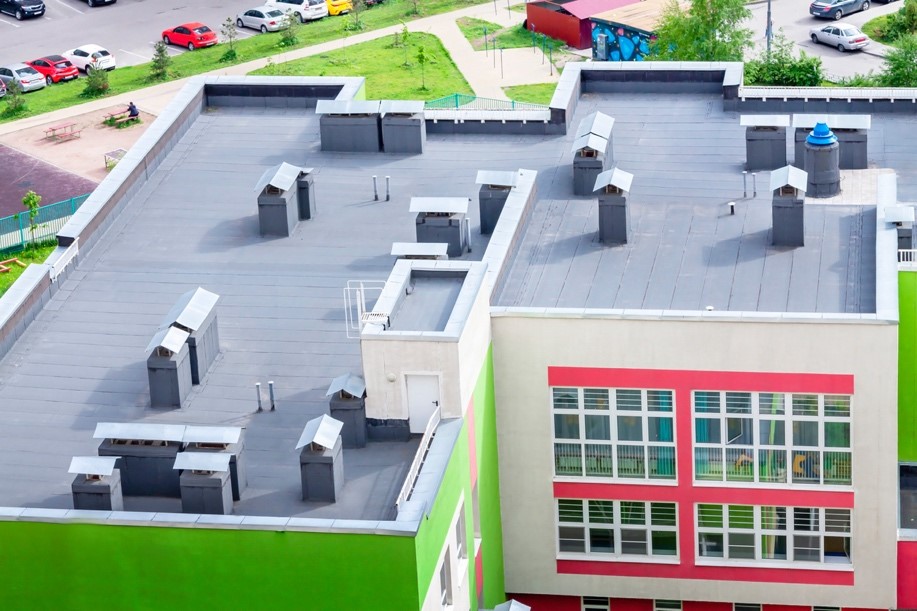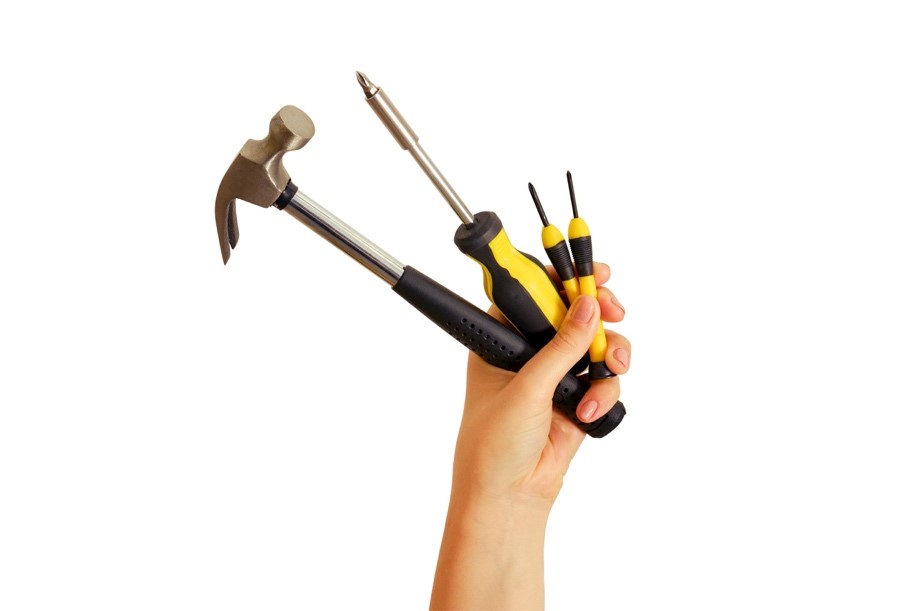Improving ventilation in schools is one of the most important ways to reduce the spread of COVID. Yet, half of all school districts have not moved past the IAQ planning stages. With government funds available, now is the time to move forward.
When I was in college, I had one class that was in the basement of an old building. It was stuffy and warm, had little ventilation and no fresh air, and smelled strongly of chicken soup that wafted in from the cafeteria next door. The course was of interest to me, but my concentration and energy were low, and I often found myself losing focus. Many school districts are taking a close look at ways to improve their indoor air quality to decrease the transmission of COVID, but improving ventilation systems in schools results in many benefits beyond reducing the transmission of viruses. IAQ is directly tied to fewer missed school days and also linked to better performances on standardized tests in math and reading.[i]

Unfortunately, schools have a long way to go to improve IAQ. Even prior to the pandemic, many schools were not properly ventilated. School leaders have been aware for some time that indoor air quality needs to be improved to reduce the spread of viruses and diseases. Studies run by the Harvard T.H. Chan School of Public Health estimate that up to 90% of schools in the US are not meeting the minimum ventilation standards established by the American Society of Heating, Refrigeration and Air Conditioning Engineers (ASHRAE).[i] Over 51% of districts surveyed had yet to implement strategies to increase ventilation or improve air filtration in more than half of the schools in their districts.[ii]
Large public school districts in New York, Boston, Los Angeles, and Vermont are leading the way in implementing robust improvements to their ventilation and filtering systems. The most frequently reported strategies used by school districts across the US were to increase outdoor air delivery and maintain continuous air flows throughout the building; replace or upgrade heating, ventilation, and air conditioning systems (HVAC); and install in-room air cleaners with HEPA filters.[iii]
Government funding through the Elementary and Secondary School Emergency Relief (ESSER) programs is available up until September 30, 2024. Improving IAQ is one of the best uses of these funds to help reduce the transmission of viruses and improve the learning environment in our schools.
Top Three Strategies to Improve IAQ
The top three strategies used to improve IAQ in schools are heavy lifts. Many school buildings have old and outdated systems and replacing them is complex and expensive. Renovating old systems is an equaling challenging task. However, we now have good models from school districts that are establishing best practices backed up by research. Massachusetts has provided a blueprint for their districts including a checklist to assist schools with IAQ compliance issues and Los Angeles (LAUSD) recently installed sensors across their district to monitor air quality to help their planning process. While Boston and Los Angeles deal with air quality issues specific to their areas – extreme temperatures, wildfires, pollution – many of the challenges addressed in these plans are relevant to districts across the country.

Ventilation: Increase Outdoor Air Delivery to the Building
Bringing in as much outdoor air as possible into schools and maintaining continuous airflow throughout the building are the most important components of any IAQ plan. Opening windows and doors, when possible, to improve airflow and using child-safe fans to maximize cross ventilation can greatly improve air quality.
Creating covered outdoor spaces with seating and tables encourages educators to hold classes and meals outside. Some school facilities managers have found that bringing in outdoor air starting two hours before the school day starts and continuing two hours after closing is helpful in generating as much fresh air as possible inside the building.

Replace or Upgrade HVAC Systems and Ensure Proper Use
ASHRE standards provide guidelines for schools to use when replacing or upgrading their HVAC systems. These projects can be costly and even with ESSER funding some schools have had to take bond proposals to residents.
New research is hoping to discover innovative ways to improve IAQ – such as ionization to charge airborne particles and pull them out of the air – but so far this research has been inconclusive. For now, replacing HVAC equipment is one of the best ways to improve IAQ and can result in savings down the road in terms of running costs. Replacing older systems also results in lowering a school’s carbon footprint. New systems are more effective at monitoring and optimizing the efficiency of the overall unit by using sensors to determine the optimal amount of air needed for each space.
For many schools, replacing their HVAC system will be cost prohibitive, but upgrading existing units can also greatly improve IAQ. Upgrading motors and other components in older equipment can make these systems much more efficient. Simple practices, such as changing the fan setting from “auto” to “on” can result in running the fan continuously to have a greater impact on IAQ. Setting up a schedule for inspection and maintenance of HVAC systems can prioritize new repairs, modifications, and replacement of equipment.

Improve Air Filtration and Cleaning
While bringing in fresh air is at the heart of any IAQ plan, removing viral or other harmful particles from the air using proper air filtration systems is also a key strategy. Replacing filters with MERV-13 filters recommended by ASHRAE can minimize the number of particulates in the air and help schools reduce allergens and viruses. Going with a higher MERV rating can result in greater improvements, but it is important to not go higher than what the current ventilation system is able to accommodate. Consider replacing filters more often than the manufacturer recommends to improve filtration.
Many schools chose to bring in portable air cleaners during the pandemic that use filtration technology, such as HEPA filters, that can reduce exposure to the virus that causes COVID.[i] Portable air cleaners can be strategically located in rooms in the school where airflow is more limited.
In New York City schools, air purifiers were initially placed in high-risk spaces such as nursing stations, but were later installed in all rooms in the schools. The city spent $85 million to install portable systems in 62,000 rooms, but the pay off was clear. Studies of this intervention found that rates of COVID were lower in comparison to other school districts as students returned to in-person classes in the Fall of 2020.[ii] Air cleaners have the added benefit of reducing the spread of flu and colds, and lessening asthma and allergies by removing dust, mold, and pollen.
District facilities managers should look for portable air cleaners that have a high efficiency air filter and are not too noisy. Units that have added features such as precipitators, ozone generators, or ionizers do not provide any additional benefits and in some cases can generate unhealthy byproducts.
Apply for ESSER Funds to Address IAQ Needs
Using ESSER III funds for upgrading HVAC systems and improving air filtration was the second most popular choice school districts made for using their ESSER funds, topped only by spending on staffing. More than $5.5 billion has been spent on IAQ in schools using ESSER funds. For many districts, having federal funds to devote to improving IAQ were the only way these projects were able to move forward. The average amount spent per school was roughly $260,000.
ESSER III funding ends on September 30, 2024. The Office of Elementary and Secondary Education provides step-by-step guidance on applying for ESSER funds. The U.S. Department of Education also provides information about how to use ESSER funds for HVAC systems
in compliance with ASHRAE standards. Also useful is the Environmental Protection Agency (EPA) Reference Guide for Indoor Air Quality in Schools that provides ways to measure IAQ and also has useful checklists and resources.
Additional resources:
-
The U.S. Environmental Protection Agency (EPA) webpage “Take Action to Improve Indoor Air Quality in Schools.”
-
The EPA “Indoor Air Quality Tools for Schools Action Kit”
-
ASHRAE’s “Managing Air Quality During the Pandemic: How K-12 Schools Addressed Air Quality in the Second Year of COVID-19”
Click Here to Read More Articles Like This
[i] US Environmental Protection Agency (2022). How Does Indoor Air Quality Impact Student Health and Academic Performance? https://www.epa.gov/iaq-schools/how-does-indoor-air-quality-impact-student-health-and-academic-performance
[ii] Allen, Joseph G., and John D. Macomber (2022). Healthy Buildings: How Indoor Spaces Can Make You Sick—or Keep You Well. Cambridge, MA: Harvard University Press.
[iii] US Department of Education (2022). Improving Ventilation in Schools, Colleges, and Universities to Prevent COVID-19. https://www.ed.gov/improving-ventilation-schools-colleges-and-universities-prevent-covid-19
[iv] New York State Department of Health (2022). Schools IAQ Update: Getting Ready for Fall 2022 and Beyond. https://www.nysacho.org/wp-content/uploads/2022/07/NYSACHO-July-2022.pdf
[v] US Center for Disease Control (CDC) (July 2021). Efficacy of Portable Air Cleaners and Masking for Reducing Indoor Exposure to Simulated Exhaled SARS-CoV-2 Aerosols. https://www.cdc.gov/mmwr/volumes/70/wr/mm7027e1.htm?s_cid=mm7027e1_w
[vi]Varma JK, Thamkittikasem J, Whittemore K, et al. (2021). COVID-19 infections among students and staff in New York City public schools. Pediatrics 147:e2021050605.








